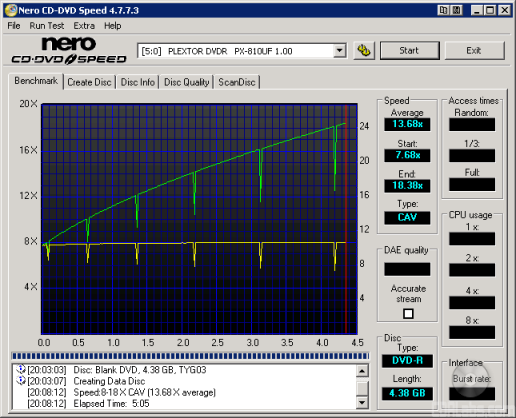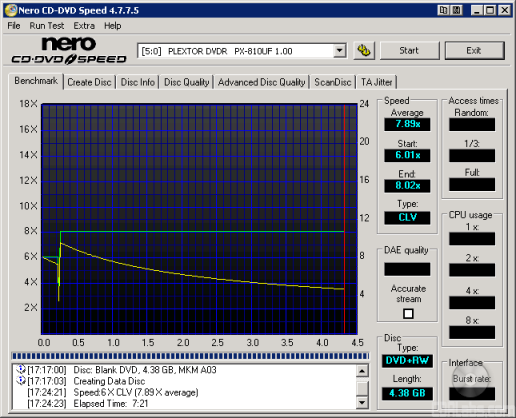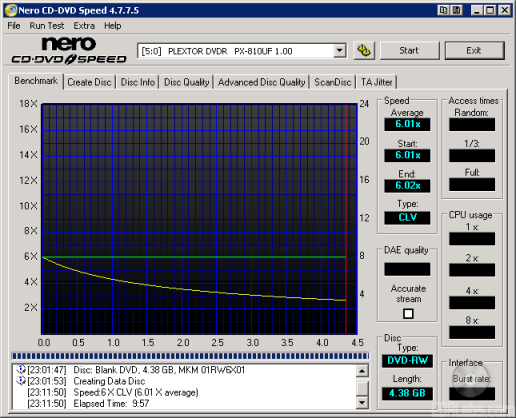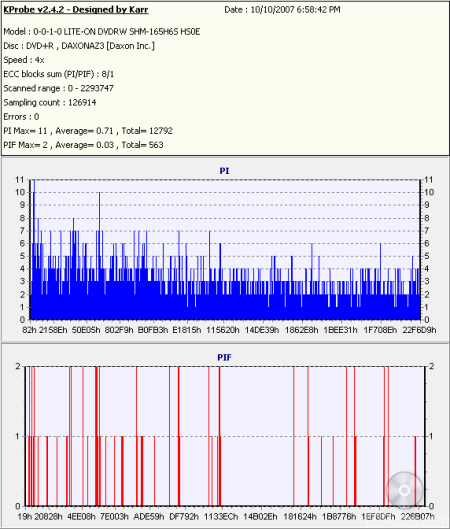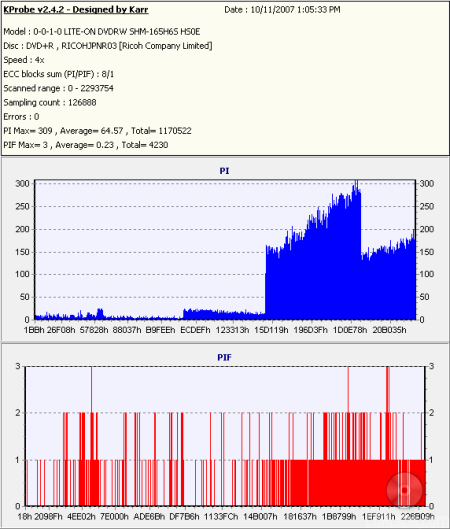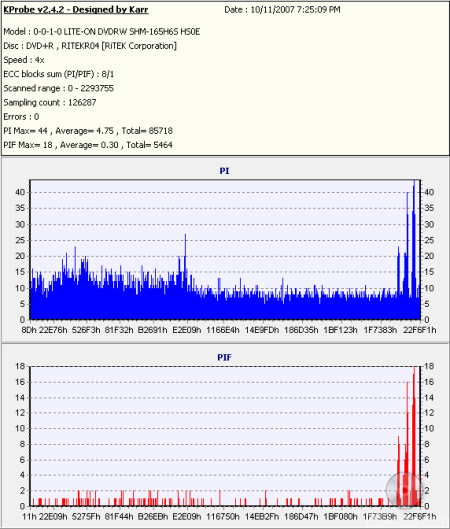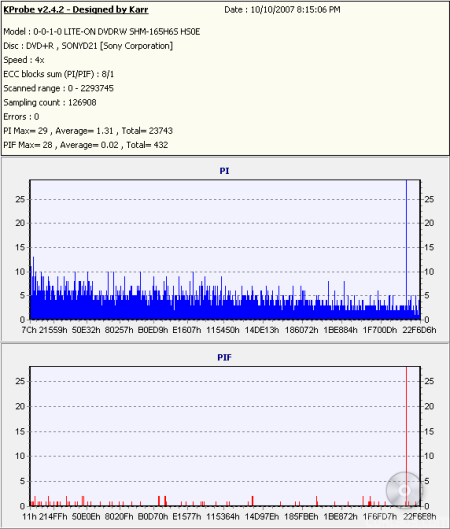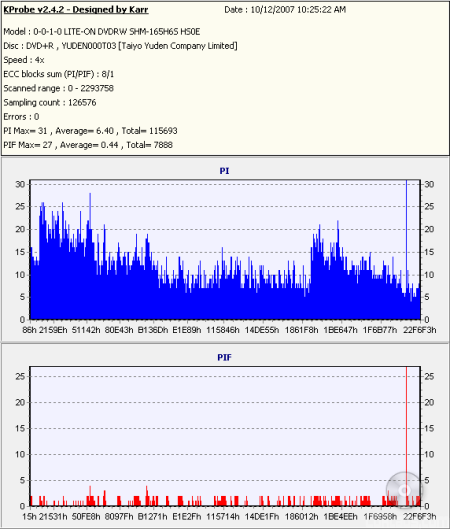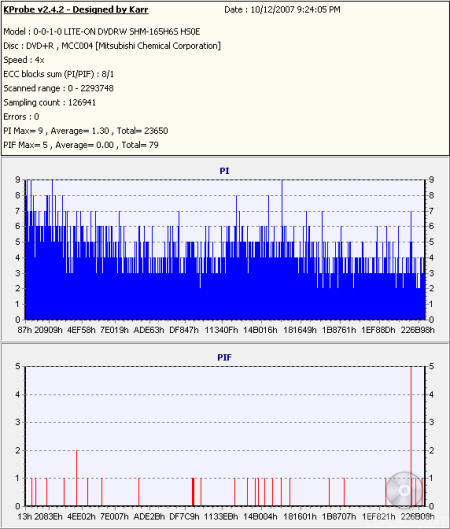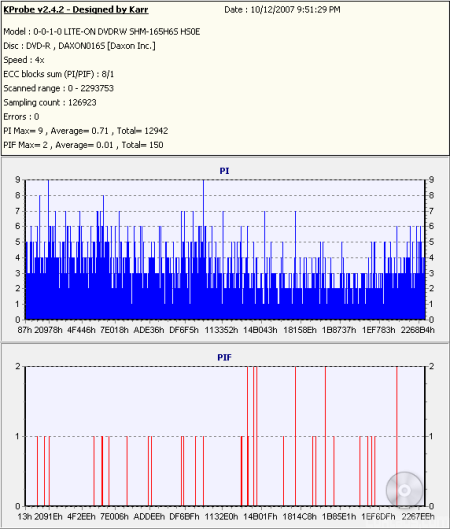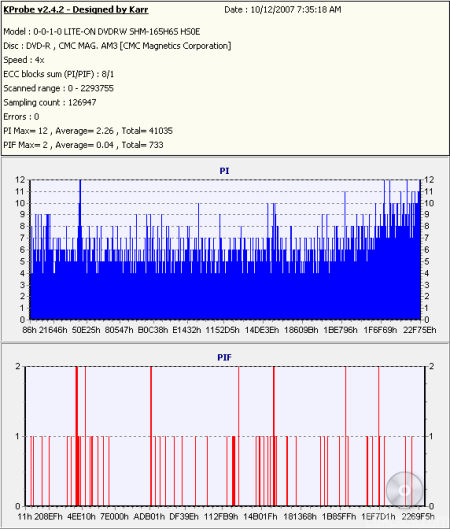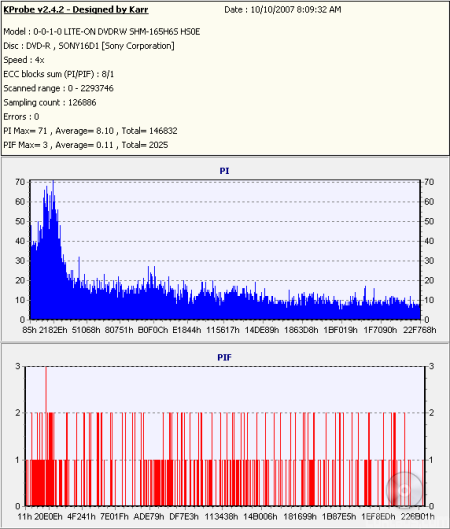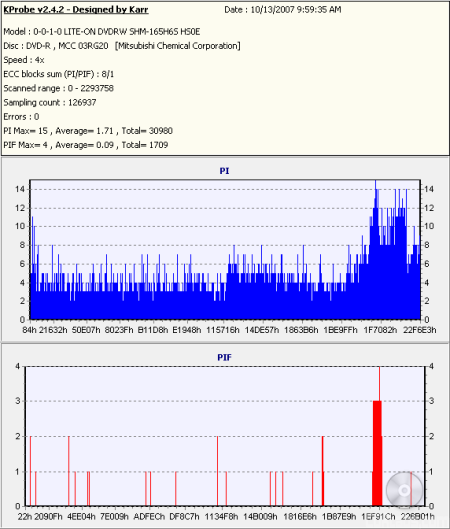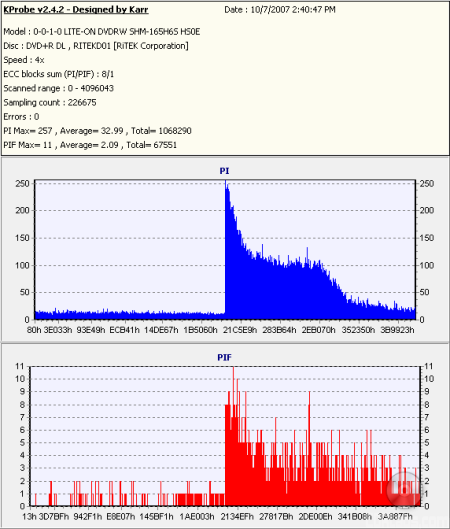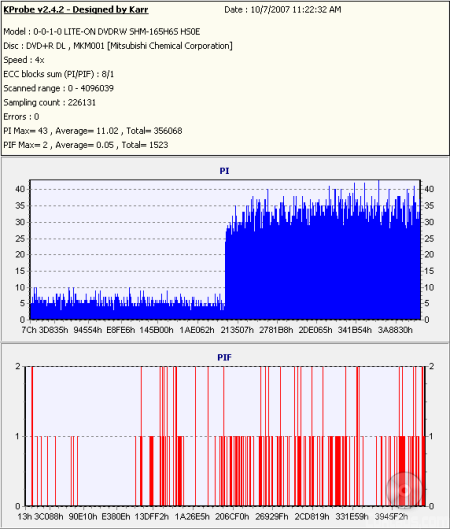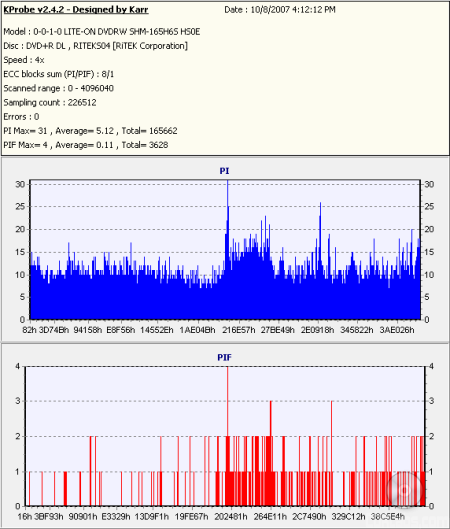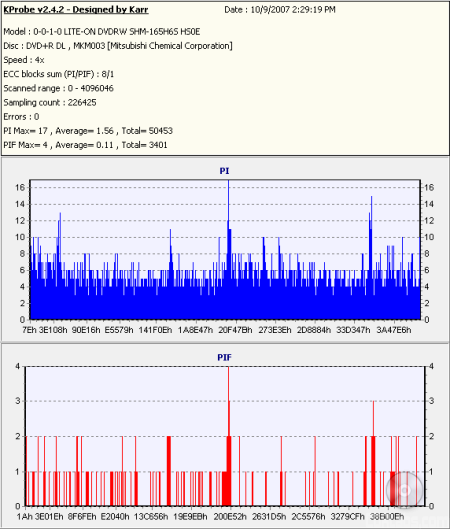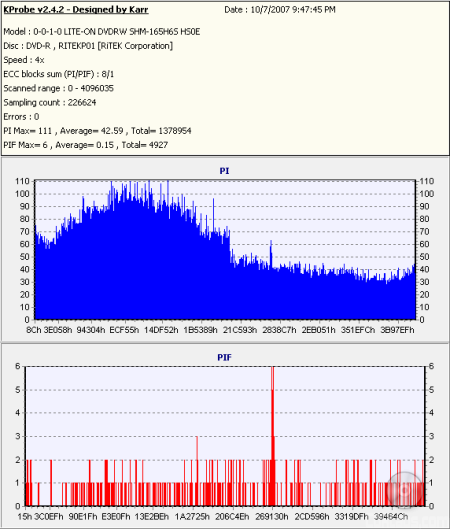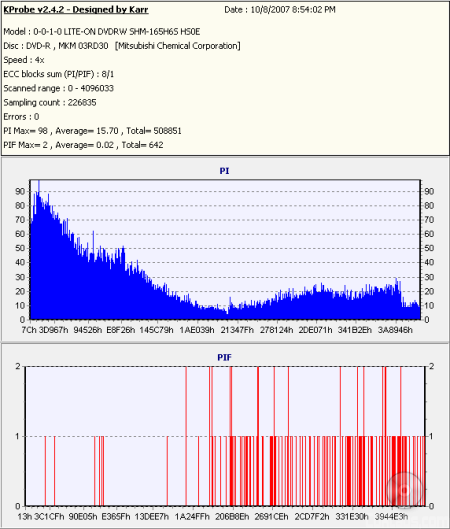DVD Write and ReWrite Tests - Nero Burning Rom 7.9.6.0 andDLA 5.20:
To test the DVD writing performance of Plextor's new drive I used Verbatim 16x DVD+R, 16x DVD-R, 8x DVD+RW and 6x DVD-RW media. To get the writing times, a 4.38GB image was burned to our test discs using Nero.
When writing to DVD+R and DVD-R media at 18x, the PX-810UF uses CAV. By looking at the screenshots above, you can see that LG's new drive starts writing at about 7x and accelerates, reaching its maximum speed at the end of the disc.
The PX-810UF also features 8x DVD+RW and 6x DVD-RW writing speeds. While the drive uses CLV when writing to DVD-RW media, it uses Z-CLV to reach its maximum DVD+RW writing speed.
| Plextor PX-810UF |
ASUS DRW-1814BLT |
LG GSA-H22N |
Samsung SH-S182D |
|
| DVD+R | 5:19 | 5:32 | 5:23 | 5:38 |
| DVD-R | 5:06 | 5:52 | 5:12 | 5:30 |
| DVD+RW | 7:19 | 7:55 | 8:17 | 8:48 |
| DVD-RW | 9:57 | 10:22 | 11:09 | 10:50 |
The PX-810UF performed very well in our DVD writing tests. While not as fast as some of the 20x DVD writers we've looked at recently, it turned in some impressive times with DVD±R and DVD±RW media.
To check the media compatibility of the PX-810UF, I ran a few tests using some of the media available in my area. The media types, along with the average time it took the drive to write our 4.38GB image, are listed below.
| Manufacturer ID | Max Write Speed |
Average Write Time |
|
| Daxon 16x DVD+R | DAXONAZ3 | 16x | 5:34 |
| Memorex 16x DVD+R | RICOHJPN R03 | 16x | 5:31 |
| RiDATA 16x DVD+R | RITEKR04 | 16x | 10:53 |
| Sony 16x DVD+R | SONYD21 | 18x | 5:37 |
| Taiyo Yuden 16x DVD+R | YUDEN000T03 | 18x | 5:33 |
| Verbatim 16x DVD+R | MCC-004 | 18x | 5:19 |
| Daxon 16x DVD-R | DAXON016S | 16x | 5:23 |
| Memorex 16x DVD-R | CMC MAG.AM3 | 16x | 5:21 |
| RiDATA 16x DVD-R | RITEKF1 | 16x | 5:20 |
| Sony 16x DVD-R | SONY16D1 | 18x | 5:16 |
| Taiyo Yuden 16x DVD-R | TYG03 | 18x | 5:04 |
| Verbatim 16x DVD-R | MCC 03RG20 | 18x | 5:06 |
So what about writing quality? Testing a drive's DVD writing quality isn't easy. Until now, there were very few options, unless you wanted to shell out thousands of dollars for a certified test machine. Thanks to KProbe, we can test a disc's PI (Parity Inner) and PIF (Parity Inner Fail) rates.For these tests I used a Lite-On SHM-165H6S (firmware HS0E) and read the discs at 4x with the PI and PIF ECC sums set to 8 and 1 respectively. For comparison, I also tested the discs on a BenQ DW1640 (firmware BSLB). When combined with Nero CD Speed, the DW1640 is able to report PI Errors, PI Failures, Parity Outer Failures and even jitter levels. For this test, the discs are read at 8x with both the PI and PIF ECC sums set to 8.
So what are "good" results supposed to look like? With KProbe, the PI errors should not exceed 280 and the number of PIF errors should stay below 4. When testing with CD Speed, the number of PI errors should stay below 280 as well. However, because it scans with an ECC sum of 8, a higher number of PIF errors is acceptable, as long as they do not exceed 32. Since POF errors are uncorrectable, we really don't want to see any of them at all.
I also put these discs through a "stress test" by reading them back at 16x with the DW1640. By reading these discs back at this speed, we can see if there are any readability issues caused by the number of errors or high levels of jitter.
|
|
|
||||||||||||||||||||||||||||||||||||||||||||||||||||||||||||||||||||||||
|
|
|
||||||||||||||||||||||||||||||||||||||||||||||||||||||||||||||||||||||||
The PX-810UF's writing quality was not as good as some of the other Plextor drives I've reviewed. In a number of cases, we saw high PI/PIF rates throughout parts of the disc. The discs written at 18x also failed to complete our stress test, returning an error near the end.
|
|
|
||||||||||||||||||||||||||||||||||||||||||||||||||||||||||||||||||||||||
|
|
|
||||||||||||||||||||||||||||||||||||||||||||||||||||||||||||||||||||||||
Lastly, here are some results from our DVD-R test media. As you can see, the PX-810UF's writing quality was much better this time around. Aside from a few small PI/PIF spikes, the results stayed within acceptable limits.
| Plextor PX-810UF |
ASUS DRW-1814BLT |
LG GSA-H22N |
Samsung SH-S182D |
|
| DVD+RW Quick | 10 seconds | 5 seconds | 4 seconds | 3 seconds |
| DVD+RW Full | 7:24 | 7:47 | 8:09 | 8:38 |
| DVD-RW Quick | 41 seconds | 29 seconds | 29 seconds | 27 seconds |
| DVD-RW Full | 10:04 | 10:10 | 11:16 | 10:50 |
To test the PX-810UF's packet writing performance I used DLA 5.20. Verbatim 8x DVD+RW, Verbatim 6x DVD-RW and Maxell 12x DVD-RAM media were used once again.
| Plextor PX-810UF |
ASUS DRW-1814BLT |
LG GSA-H22N |
Samsung SH-S182D |
|
| DVD+RW Write | 6:30 | 6:56 | 7:39 | 7:53 |
| DVD+RW Read | 6:15 | 8:57 | 6:38 | 8:57 |
| DVD-RW Write | 8:24 | 8:36 | 9:28 | 9:15 |
| DVD-RW Read | 6:17 | 9:02 | 6:24 | 8:59 |
| DVD-RAM Write | 11:18 | failed | 13:43 | 13:50 |
| DVD-RAM Read | 5:33 | failed | 5:31 | 5:26 |
Plextor's new drive performed very well in our packet writing tests. The PX-810UF turned in some very good times when reading and writing to DVD+RW, DVD-RW and DVD-RAM media.
Double Layer DVD Write Tests - Nero Burning Rom 7.9.6.0:
To test the double layer DVD writing performance of the PX-810UF, I used DVD+R DL and DVD-R DL media from Verbatim, RiDATA, MAM-A and Memorex. I created about 8GB of random files and directories on my hard drive and then burned them to our test discs with Nero.
Finding DVD+R DL media that would work at 10x was not an easy task. The only media I found that would work at this speed were Verbatim's 8x DVD+R DL discs. With the 8x DVD+R DL media from RiDATA and MAM-A, the writing speed was limited to 8x and the other discs would not work at anything faster than 4x.
| Plextor PX-810UF |
ASUS DRW-1814BLT |
LG GSA-H22N |
Samsung SH-S182D |
|
| DVD+R DL Write | 14:07 | 18:33 | 19:17 | 18:34 |
The PX-810UF had no problems taking the top spot in this test. Thanks to its 10x DVD+R DL writing speed, the drive took a little more than 14 minutes to write 8001MB of data. So what about writing quality? Take a look below.
|
|
|
||||||||||||||||||||||||||||||||||||||||||||||||||||||||||||||||||||||||
|
|
||||||||||||||||||||||||||||||||||||||||||||||||
The writing quality was fairly good with the DVD+R DL media from MAM-A, RiDATA and Verbatim. Aside from a few isolated spikes, the PI/PIF rates stayed within acceptable limits. Unfortunately, the same can't be said for Memorex's 2.4x DVD+R DL media. When tested with KProbe and CD Speed, the error rates were fairly high throughout the second layer of the disc. Oddly enough, this didn't have any effect on readability.
The PX-810UF also features 8x DVD-R DL writing speeds. To test the drive's writing times, DVD-R DL media from Verbatim and RiDATA was used.
| Plextor PX-810UF |
ASUS DRW-1814BLT |
LG GSA-H22N |
Samsung SH-S182D |
|
| DVD-R DL Write | 14:13 | 23:33 | 19:15 | 18:43 |
The PX-810UF also performed very well when writing to DVD-R DL media. In our tests, it took only 14:13 to write 8001MB of data, beating the other drives by a sizeable margin. So what about writing quality? Take a look below.
|
|
|
||||||||||||||||||||||||||||||||||||||||||||||||||||||||||||||||||||||||
While the writing quality was pretty good with Verbatim's 4x DVD-R DL media, the other discs yielded some mixed results. With Verbatim's 8x and RiDATA's 4x DVD-R DL media, the error rates stayed well within acceptable limits when tested with KProbe. However, when scanned by the DW1640, the PI rates were a bit higher than we'd like to see.
Performance Revisited:
While Plextor's new "Super-Multi" drive has a few rough spots, it performed pretty well throughout most of our tests. The PX-810UF flew through our DVD writing tests, turning in some impressive times with DVD±R, DVD±R DL and DVD-RAM media. Unfortunately, there were a few cases where the writing quality could have been better. Reading DVD's wasn't a problem for the PX-810UF either. The drive was able to read single layer data DVD's and DVD±R media at 16x, but slowed to about 4.8x when reading DVD videos.
The PX-810UF also did relatively well in our CD read tests. While its seek times were a little higher than I would have liked, the drive was able to read pressed and CD-R media at speeds as high as 48x. Plextor's new drive also performed very well in our writing and rewriting tests. The PX-810UF turned in some impressive writing times and its writing quality was pretty good with the media we tried. With all things considered, the Plextor PX-810UF gets a 7 out of 10 for the performance section of this review.



